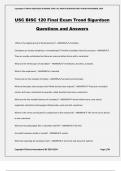Exam (elaborations)
USC BISC 120 Final Exam Trond Sigurdsen Questions and Answers
Institution
Practice Tests
USC BISC 120 Final Exam Trond Sigurdsen
Questions and Answers
What is the largest group of deuterostomes? - ANSWER-chordates
Chordates are mostly vertebraes or invertebrates? Primitive chordates have this structure - ANSWER-
They are mostly vertebrates but there are some primitive forms with a ...
[Show more]
Preview 4 out of 38 pages
Uploaded on
November 4, 2024
Number of pages
38
Written in
2024/2025
Type
Exam (elaborations)
Contains
Questions & answers
Institution
Practice Tests
Course
Practice Tests
$12.49
100% satisfaction guarantee
Immediately available after payment
Both online and in PDF
No strings attached
Copyright © KAYLIN 2024/2025 ACADEMIC YEAR. ALL RIGHTS RESERVED FIRST PUBLISH NOVEMBER, 2024




